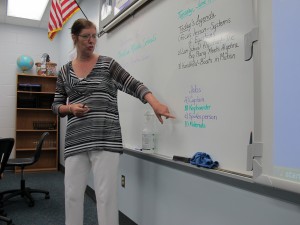Opinion: For Better Teachers, Larger Classes And Higher Salaries

John O'Connor / StateImpact Florida
Sarasota County middle school math teacher Brenda Fuoco, in 2013.
Maybe a charter school in New York City has discovered “The Answer” to Florida’s K-12 education challenges?
If so, the school has done so by setting aside Florida’s focus on keeping class sizes small and by instead adopting a strategy that our state has so far ignored – recruiting star teachers with high salaries and an attractive working environment. In particular, the school’s spectacular results in math achievement should provide the standard by which Florida’s efforts to prepare students for careers in STEM — science, technology, engineering and mathematics — fields are judged.
The New York City charter, which teaches grades 5-9, is called The Equity Project (TEP). It pays its teachers a $125,000 salary – with bonuses based on student achievement. The salary seems extravagant in part because the cost of living in New York City is so high. An equivalent salary in Tampa would be $71,000, according to Bankrate.com – still considerably higher than the average Florida teacher salary of about $46,000.
In addition to the high salary, the TEP teachers have time to plan and collaborate, and a six-week professional development program is built into each summer. The teachers take a large role in school-wide decision-making.
The teachers also assume many administrative tasks, eliminating nearly all administrative positions and thus freeing resources for teaching. The average class size is large at 31 students, much larger than Florida’s constitutionally mandated limit of 22 for middle schools. Once again, this frees up resources for other uses, including supporting the high salaries.
The application process for teaching positions at TEP is rigorous, and about half of the first-year teachers who survive the application process either resign or are not rehired for the second year. The typical teacher hired by TEP already has six years of teaching experience.
The school is located in a challenging New York City neighborhood and has a student population that is nearly identical to those of the traditional public schools in the same vicinity.
The results? A study by Mathematica Policy Research shows that students who attended the school from 2009 to 2013 – for four years – learned 5.6 years’ worth of math – 1.6 years’ worth of math more than their peers at neighboring traditional public middle schools.
The math achievement gap between Hispanic and white students was mostly eliminated. Students also learned considerably more science (about 0.6 years more) than their peers at nearby middle schools, and their achievement in English language arts was also greater than at the neighboring schools by 0.4 years.
These results aren’t particularly surprising. We’ve always known that great teachers can have a tremendous impact on students.
And the fact that the most dramatic improvements are in math isn’t surprising, either. Researchers at Michigan State University recently demonstrated that middle school math teachers in the US are weaker at doing math themselves than their counterparts in nations with which we compete like Taiwan, Singapore and Poland.
New bachelor’s degree graduates in mathematics generally earn considerably more than starting K-12 teachers, making it difficult for a young person with strong math skills who wants to start a family to choose a teaching career. TEP’s $125,000 salary not only solves that problem, but also makes middle school teaching the best financial option for many with strong math skills.
So here is the next big question: Would educational decision-makers in Florida – legislators, Department of Education leadership, teachers’ union officials and even parents and taxpayers – be willing to replicate this school on a large scale?
Would we be willing to pay early career teachers $71,000 in Tampa to get the same results as the TEP school did in New York City? Would legislators, school board members and taxpayers be willing to support that?
Maybe we should limit that $71,000 salary to early career teachers in schools like TEP that host large numbers of high-needs students. Would teachers’ unions be willing to allow a large pay differential between schools with many high-needs students and those with less challenging student bodies?
And maybe we should further focus these high salaries on math teachers, where the high salaries at TEP appeared to have the most impact. There’s another conundrum for the teachers’ unions.
In fact, both of those salary differential schemes would be challenging for Florida’s charter schools, which are not known for paying higher salaries than the traditional public schools.
Are parents willing to allow class sizes of 31 students to help provide the resources needed for these higher salaries?
Maybe TEP has found “The Answer” to Florida’s K-12 challenges. If so, we are all going to have to look in the mirror and ask ourselves whether we are ready to make the investments and sacrifices it will take to accept it.
Paul Cottle is a physics professor at Florida State University and writes about education issues at his blog, Bridge to Tomorrow.


